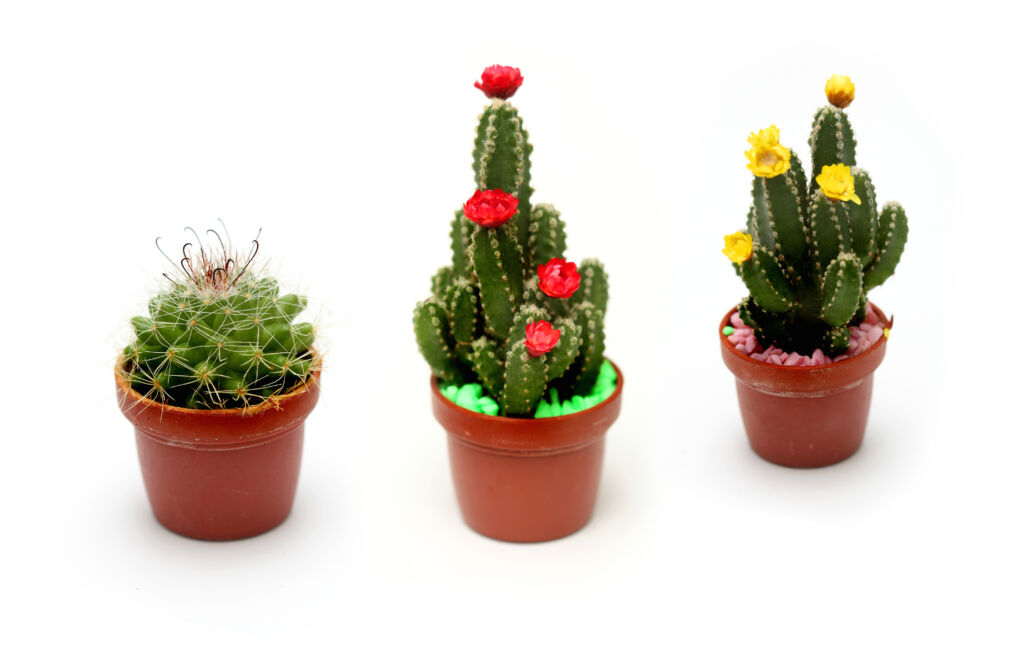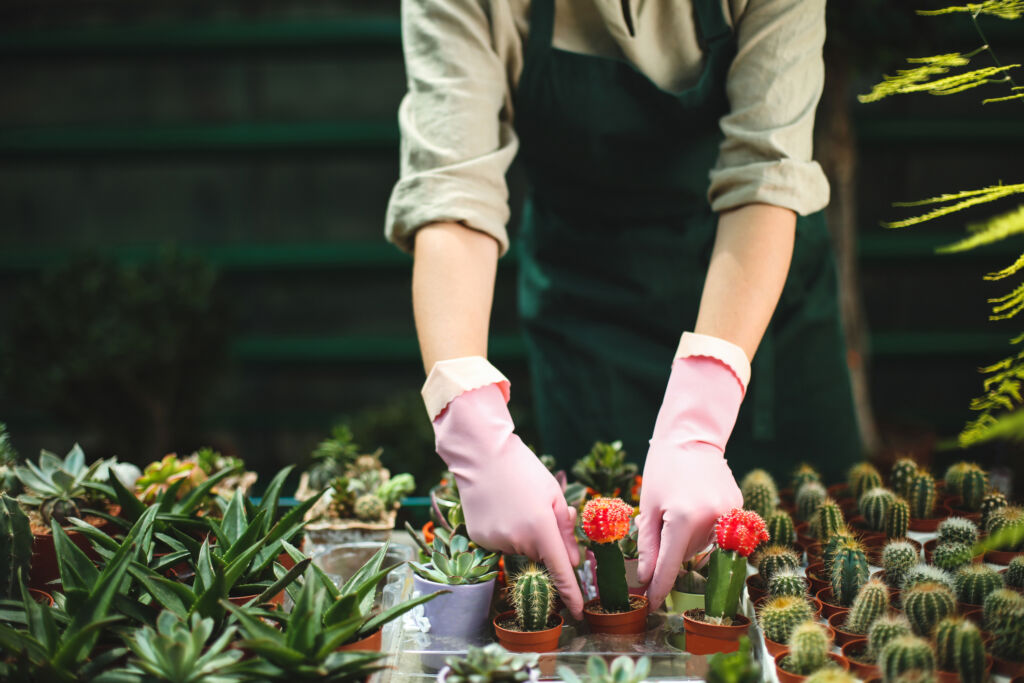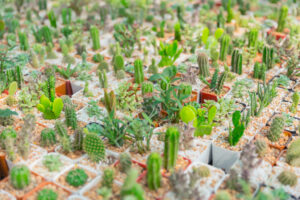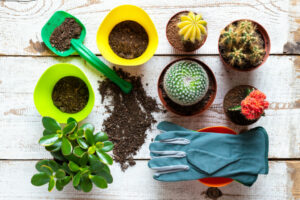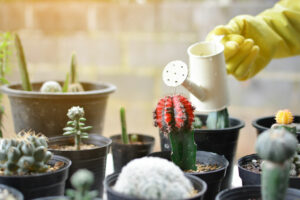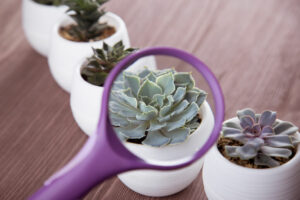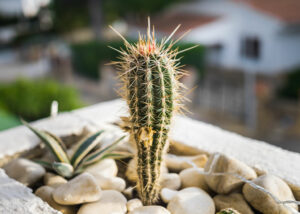HousePlantJoy is supported by our audience. When you purchase through one of our links, we may earn a small affiliate commission. As an Amazon Associate I earn from qualifying purchases. Your cost is not affected.
==================
How to Care for a Cactus
Knowing the art of how to care for a cactus is essential for keeping your cactus thriving. Keep these pro tips in mind to learn how to keep a cactus alive.
The idea of placing a cactus on your patio is beautiful. But you have to be extra watchful to make sure that your cactus keep thriving. I always love these cacti because they are easy to manage and look beautiful. They can be your perfect roommates as they are easy to grow and need less attention.
Plus, depending on the type of your cactus, they will produce enchanting pink, red, blue, white, or yellow flowers during the bloom season.
As a novice, it is important to learn the art of how to take care of cactus succulents or how to take care of cactus with flowers. One of the biggest issues that can end up with your cactus rotting is overwatering them. So, it is critical to keep them in the right conditions to make them live for decades.
Here’s a beginner guide on how to keep a cactus alive and how to take care of cactus with flowers. So, let’s get started!
man taking care of cactus
Identifying the Type of Cacti
Knowing the type of your cactus is important to take care of cactus and succulents. There are thousands of different cacti species, and they thrive in different conditions. Some love thriving in dry sandy soils, while some grow well in tropical rainforests. So, when purchasing cacti for your home, ensure you know its species and learn what type of conditions it likes.When identifying your cacti, the most significant factor of a cactus is its ability to store water for longer periods. These plants are also known for their ability to survive in extremely dry environments of desert land.
While all the cacti are succulents, the major factor of these cacti is their areoles, which cannot be seen in succulents. It is essential to recognize the particular species of cactus you are planning to grow. For example, while most cacti love flirting with high temperatures, low moisture, and sunny climates, some do well in rainforests like Epiphyllum.
Hence, it is critical to be watchful of the native environment in which your cacti thrive. Whether you have a prickly pear cactus or want to take care of cactus with flowers, providing the best possible growing conditions can help achieve the best results to keep a cactus alive.
Some common types of cacti include:
- Peruvian Apple (Cereus peruvianus)
- Rat’s Tail (Aporocactus Flagelliformis)
- Bunny Ears (Opuntia Microdasys)
- Orchid (Disocactus Ackermannii)
- Christmas (Schlumbergera Bridgesii)
- Golden Barrel Cactus (Echinocactus Grusonii)
Preparing the Ideal Environment
Once you are sure about your cactus type, provide it with the right environment to keep a cactus alive. In this regard, you want an open and free draining pot. While this will help prevent waterlogging, it will also recreate a suitable habitat for your cactus.For the most part, you can place your cactus on a window sill all year round; however, some cacti, such as Rhipsalis, love sitting in a semi-shaded environment. So, make sure to adhere to the requirements to take care of a cactus in the best possible way. In terms of temperature, most cacti love having a minimum of 8 to 10°C at night.
9 Essential Tips to Care For a Cactus
1. The Potting Mix
As mentioned, several cacti species live in different conditions. In addition to providing an appropriate location, having an appropriate potting mix is essential to keep a cactus alive. Remember that using an arid potting mix for tropical cacti will not work.If you go with cacti that thrive in tropical rainforest-like Epiphyllums, ensure to use an appropriate potting mix soil. Tropical cacti drain instantly because they are suspended in trees, and their roots don’t rot because of overwatering.
For such cacti species, you should use well-draining soil. Moreover, for tropical cacti, a little more organic matter in your potting mix is also essential to take care of cactus and succulents.
On the flip, some cacti thrive in arid areas. Forcing them to grow in soils that drain poorly will eventually kill your plant. So, using a purchased potting mix specifically designed for these species is essential to keep a cactus alive.
How to Make Best Cacti Soil?
Preparing an ideal soil is essential to take care of the cactus with flowers and keep it thriving. There are plenty of potting mixes in the market that is ready to use. So, you can purchase such soil to avoid spending your time making one. However, if you still want to make your potting mix to provide the right nutrients to your cacti, here are the tips:
- Whether you have an arid or tropical cactus, make sure to use equal portions of peat moss and ground fir bark.
- For tropical species, they require more moisture than arid species. So, ensure to use the mix above to add the builder’s sand. Moreover, if you go with a desert cactus, you can opt for vermiculite or pumice.
- Mix everything well and with care to ensure the mixture blends evenly.
- Water the mixture before you use it in your cactus pot. Give it some time to absorb the water.
- At this stage, avoid feeding it any fertilizer because your cacti have minimal nutrient needs.
2. Watering Your Cacti
Although some cacti thrive in arid areas, they still need water. Therefore, even if you go with the arid cacti species, you will have to prepare a watering schedule to take care of cactus with flowers. These succulents are naturally juicy, meaning they store moisture.They can also store water that they can use during the dry season. While they can survive quite some time without water, you can still guess when they need it as they start yellowing. Moreover, most cacti species grow in the warmer seasons, and during this time, they need adequate water. Similarly, they require less moisture in the colder seasons (winter and spring).
Watering during the colder season means you can water your cactus once a week. You can also guess its water needs by observing the soil. I also recommend using a water gauge to determine the soil moisture.
Remember that watering your cacti too much can cause root rot, making them turn pale. Alternatively, you can also use a stick and poke the soil to check the water at the bottom. If you see soil sticking on the stick, it means there’s still some water.
Tips on Watering your Cacti
Here are a few tips that will help to take care of cactus with flowers in the best possible way:
- The Size of Cactus
Generally, you’d think the bigger your cactus in size is, the more it needs water. However, smaller and younger cacti experience a higher growth rate in the real sense, which means they also need more water. In simple, a smaller cactus needs more water than the large one.
- The Size of the Pot
Smaller pots are ideal since cacti don’t like sitting in water to avoid root rot. Using large cacti pots also takes more time to drain water, making your succulent susceptible to not thriving. So, using just enough pot to keep a cactus alive is essential.
- The Type of Pot
Apart from the type of port, consider if the soil is aerated. Unlike terra cotta pots, using a plastic pot will take more time to dry out. While they ensure adequate air movement, these pots also drain excess water faster, preventing root rot.
3. Feeding Fertilizer to Your Cactus
Nutrients are essential to keep your plant thriving. It is important to get a cacti-designated fertilizer to care for a cactus. These fertilizers help supply nutrients to enhance growth. Most cacti experience growth during warm seasons.When purchasing a cacti-designated fertilizer, make sure to get one high in phosphorus and low in nitrogen. It is essential to take care of cactus succulents to maintain healthy growth. Moreover, also make sure to keep analyzing your cacti during spring to observe new growth. If you see any new growth, it’s time to apply fertilizer.
In addition, when using cacti-designated fertilizer, maintain a ratio of one tablespoon of low nitrogen with a gallon of water. Use this for watering your cacti every eight weeks during warmer months.
TIP: Recently potted or repotted cacti don’t require fertilizer until they establish themselves in the new pot. The process can take up to two months. Moreover, some cacti species, such as Christmas cacti, bloom in colder months and remain dormant during warm. In such a case, they need fertilizing in winter.
4. Flirt with Sunlight
Sunlight is essential to take for of cactus with flowers. Cacti species like desert cacti love flirting directing sunlight. They should be provided with at least four hours a day of direct sunlight to maintain their healthy look. At the same time, tropical cacti like Christmas cacti love thriving in partial shade.During colder months, tropical cacti like Rhipsalis need direct sunlight because that’s their bloom season. Exposing them to direct sunlight enhances their growth.
In order to keep a cactus alive indoors, make sure that they’re four feet from the window and facing south or east to get adequate sunlight. However, also keep your succulents rotating to avoid getting your cacti turning yellow due to excessive sunlight.
During winter and autumn, make sure your cacti sit in a temperature ranging between 8°C-10°C. While in summer or spring, they can survive in higher temperatures if they get proper ventilation. To keep a cactus alive indoors, make sure to rotate it every month. This is because indoor cacti tend to grow towards the light.
The Use of Artificial Lights
In case you are not able to provide your cacti with adequate sunlight, you can use artificial lights. There are three kinds of growth lights; Fluorescent lights, Light-emitting diodes (LEDs), and High-intensity discharge (HIDs).
- Using fluorescent lights to grow vegetables and herbs indoors is an excellent solution.
- If you go with HIDs, make sure to place your cactus a distance away to protect it from the heat emitted by HIDs. Moreover, they are also costly to set up and have a temperature-management system.
- LEDs are more efficient than the other two types. Not only is their light more focused, but they also produce minimal heat.
5. Be Aware of Pests
In order to take care of cactus with flowers, the biggest concern is bacterial and fungal diseases raised by overwatering. However, pests and mealybugs can also attack them. Protecting your cacti from these pests can be challenging because they become stubborn or keep recurring to damage your plants.
Mealybugs and Scale
If you want to keep a cactus alive, you should always look for the most common insects, such as mealybugs and scale. These insects can get past the spines, causing a lot of damage and eventually killing your plant.With a white, waxy, and cotton appearance, mealybugs are difficult to spot as they live in hidden parts. You can find them under the leaves and joint areas. In contrast, some attack stems and leaves; others damage the roots by sucking the juice.
Spider mites
If you spot any webbing or small brown dots on the leaves, it means your cactus is under the attack of spider mites. They are also hard to notice because of their tiny size and resemblance to dust. However, you can tap the damaged area to remove them.
Fungus Gnats
Fungus gnats are another common threat that can damage your cactus. They look like mosquitoes and hover around the soil. The larva sitting in the soil consumes the organic matter, leaving it without nutrients.Now, here’s how to manage these pests to take care of cactus with flowers:
- The methods you use to nurture your cacti can be deciding to keep a cactus alive. Make sure your succulents get adequate water, drainage, and sunlight. Keeping your cactus thriving and healthy can decrease the risk of pests attacks. Moreover, keep the pots clean and free from dead leaves to avoid attracting pests.
- Keep the infected cactus away from your new cacti collection to prevent the risk of transferring pests. You can quarantine infected cacti until they get rid of pests.
- An already infested cactus can be healed using cotton swabs dipped in alcohol. This will help remove these insects away from your plant. Some people spray their plants with an alcoholic solution diluted in water that can potentially damage the plant’s epidermis. Still, if you want to use this technique to remove insects, test the solution on a small area before spraying the whole plant.
- In the case of spider mites, you can wash them away with water. However, e sure to cover the pot to avoid overwatering.
- Using insecticidal soap can be helpful to take care of a cactus and wash off the pests. However, be aware that it can also damage your cactus as it has wax. So, it is important to read the label first and use only the cactus-designated insecticidal soap to keep a cactus alive.
6. Know Your Cactus Needs
Like babies, your cactus is delicate and requires keen observation to know what works best for them and what doesn’t. If you want to take care of a cactus with flowers in the best possible way, you should keenly observe their growth. Their growth rate will also help you figure out what they are lacking.For instance, if the cactus in your window is experiencing growth towards the sunlight, it means they are getting inadequate light. You can rotate your cactus or change its place to get more lighting. Similarly, if you observe fading, it means your plant is exposed to excessive sunlight. Moving it to a less light area will help keep a cactus alive.
7. Repot Your Cactus
If the roots of your cactus are expanding and going out of the pot, it’s time to report it. Although cactus is tolerant and does not require much attention, you still need to take care of a cactus to ensure proper growth. Repotting your cactus every 3-4 years is essential.If you are planning to report your cactus, these tips are essential to keep a cactus alive:
- Gather Necessary Tools
Before repotting your cactus, gather these necessary tools:
- A unique potting mix.
- A blunt or dull knife.
- A new pot.
- Gravel or crocks.
- Barbeque tongs.
- Leather gloves.
- Potting Mix
Get a potting mix that should be a size up to the previous one. Use newspaper to wrap your cactus in layers and secure it with tape.
- Loosen the Soil
Loosen the soil using a blunt or dull knife to remove the cactus. Be very careful to make sure you don’t damage your cactus. Use your leather gloves to gently pull the plant out. Alternatively, you can also use barbeque tongs to get your plant out.
Keep in mind that different cactus species come with different spine sizes. For instance, prickly pear features small, hard-to-notice spines that can lodge in your skin. So, it is important to use gloves as protection.
- Clean the Roots
After pulling your cactus out, clean out the roots to brush off the soil. Also, carefully observe the roots for pests and rot. In case of any pests, it is important to use a cactus-designated insecticide to keep a cactus alive. Moreover, cut off dead roots, if any.
- Let the Roots Dry
During repotting, you may have damaged some of its roots, and transferring it immediately to a new pot may affect the growth of your plant. So, when repotting, letting the roots dry is an important step to take care of cactus with flowers. You can leave your plant for a couple of days to prevent infection.
- Transfer Your Cactus to a New Pot
Once the roots are dry, you are now ready to report your cactus. However, make sure to use a pot that is a size larger than the previous one to support new growth. Using a large pot means high water retention, which can cause root rot.
- Add Soil
Before adding any soil to the new pot, add some gravel to enhance water drainage. Use the potting mix to keep your cactus planted.
- Plant Your Cactus
Once you are done adding soil, use barbeque tongs to place your cactus at the center of the pot. Use gentle hands, or you could damage its roots. Add more soil to hold the cactus and ensure the roots are entirely covered. You can also add some compost to maintain acidity.
Avoid watering for some days after repotting your cactus to a new pot. If a particular species is more susceptible to rot, wait for a couple of weeks before watering. Once your plant is established and recovered, you can care for a cactus and water it.
8. Provide Sufficient Air
Keep in mind that stiff breezes can kill your plant. Cacti thrive in places with proper air circulation. In order to keep a cactus alive indoors, ensure to provide the right conditions. You can open your windows and vents for proper ventilation.
9. Pruning Your Cactus
Depending on your cactus species, pruning can help you keep a cactus thriving. While it is not necessary, pruning can help you maintain your cactus’s shape and beautiful look. Occasional pruning can prevent outgrown specimens and overcrowded areas. In order to take care of cactus with flowers, the occasional dust will keep your succulent look fresh.
Wrapping it Up
That’s all about how to take care of a cactus. They are great houseplants, easy to grow, and require minimal attention. Whether in your room or kitchens, cacti are a great addition. If you are a beginner, the above tips should help you keep a cactus alive and thriving for decades.
FAQs
How to take care of prickly pear?
If you want to keep your prickly pear cactus thriving, avoid overwatering, provide it with some direct sunlight, and ensure proper air circulation.
Read More:

